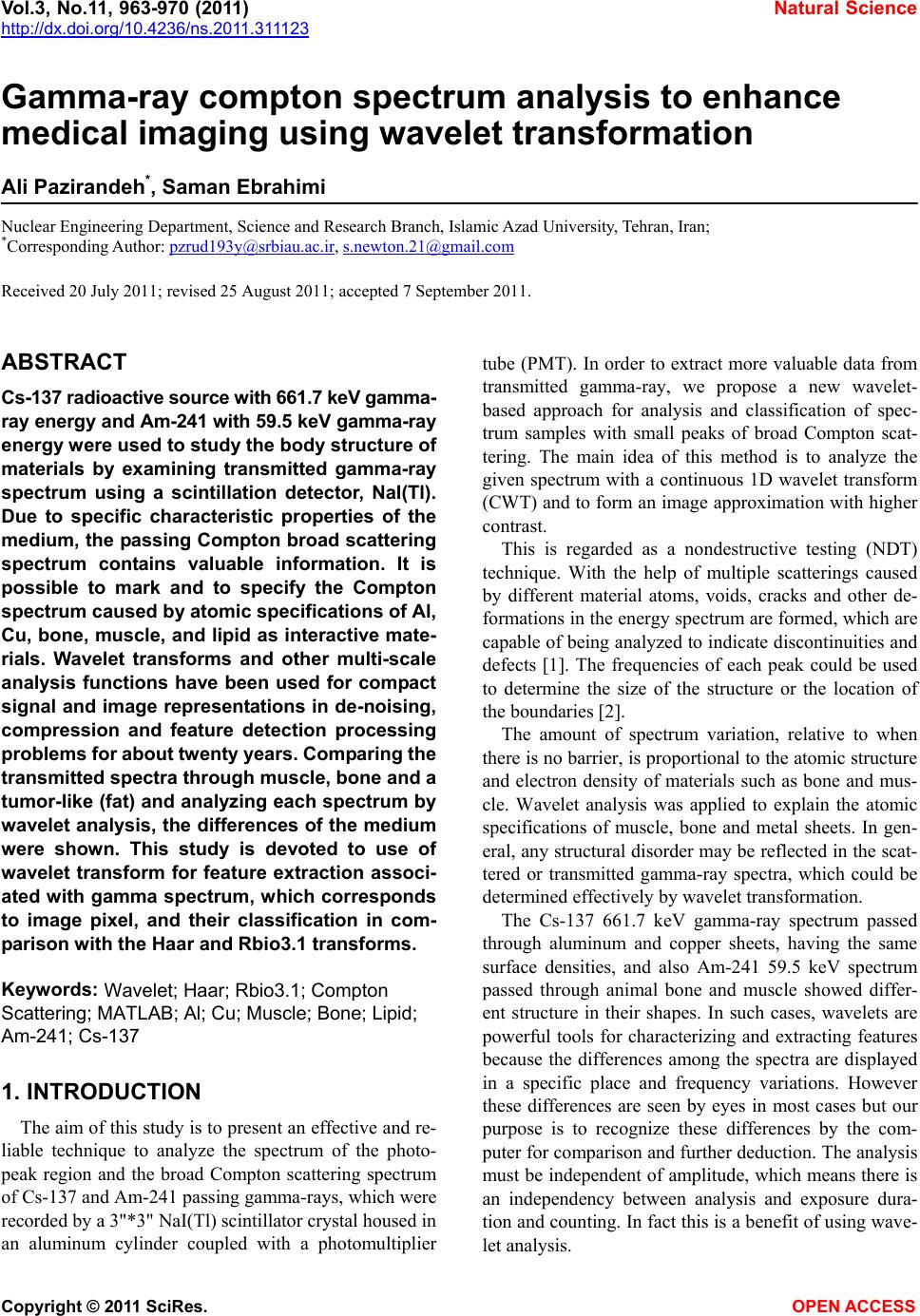
Vol.3, No.11, 963-970 (2011) Natural Science
http://dx.doi.org/10.4236/ns.2011.311123
Copyright © 2011 SciRes. OPEN ACCESS
Gamma-ray compton spectrum analysis to enhance
medical imaging using wavelet transformation
Ali Pazirandeh*, Saman Ebrahimi
Nuclear Engineering Department, Science and Research Branch, Islamic Azad University, Tehran, Iran;
*Corresponding Author: pzrud193y@srbiau.ac.ir, s.newton.21@gmail.com
Received 20 July 2011; revised 25 August 2011; accepted 7 September 2011.
ABSTRACT
Cs-137 radioactive source with 661.7 keV gamma-
ray energy and Am-241 with 59.5 keV gamma-ray
energy were used to study the body structure of
materials by examining transmitted gamma-ray
spectrum using a scintillation detector, NaI(Tl).
Due to specific characteristic properties of the
medium, the passing Compton broad scattering
spectrum contains valuable information. It is
possible to mark and to specify the Compton
spectrum caused by atomic specifications of Al,
Cu, bone, muscle, and lipid as interactive mate-
rials. Wavelet transforms and other multi-scale
analysis functions have been used for compact
signal and image representations in de-noising,
compression and feature detection processing
problems for about twenty years. Comparing the
transmitted spectra through muscle, bone and a
tumor-like (fat) and analyzing each spectrum by
wavelet analysis, the differences of the medium
were shown. This study is devoted to use of
wavelet transform for feature extraction associ-
ated with gamma spectrum, which corresponds
to image pixel, and their classification in com-
parison with the Haar and Rbio3.1 transforms.
Keywords: Wavelet; Haar; Rbio3.1; Compton
Scattering; MATLAB; Al; Cu; Muscle; Bone; Lipid;
Am-241; Cs-137
1. INTRODUCTION
The aim of this study is to present an effective and re-
liable technique to analyze the spectrum of the photo-
peak region and the broad Compton scattering spectrum
of Cs-137 and Am-241 passing gamma-rays, which were
recorded by a 3"*3" NaI(Tl) scintillator crystal housed in
an aluminum cylinder coupled with a photomultiplier
tube (PMT). In order to extract more valuable data from
transmitted gamma-ray, we propose a new wavelet-
based approach for analysis and classification of spec-
trum samples with small peaks of broad Compton scat-
tering. The main idea of this method is to analyze the
given spectrum with a continuous 1D wavelet transform
(CWT) and to form an image approximation with higher
contrast.
This is regarded as a nondestructive testing (NDT)
technique. With the help of multiple scatterings caused
by different material atoms, voids, cracks and other de-
formations in the energy spectrum are formed, which are
capable of being analyzed to indicate discontinuities and
defects [1]. The frequencies of each peak could be used
to determine the size of the structure or the location of
the boundaries [2].
The amount of spectrum variation, relative to when
there is no barrier, is proportional to the atomic structure
and electron density of materials such as bone and mus-
cle. Wavelet analysis was applied to explain the atomic
specifications of muscle, bone and metal sheets. In gen-
eral, any structural disorder may be reflected in the scat-
tered or transmitted gamma-ray spectra, which could be
determined effectively by wavelet transformation.
The Cs-137 661.7 keV gamma-ray spectrum passed
through aluminum and copper sheets, having the same
surface densities, and also Am-241 59.5 keV spectrum
passed through animal bone and muscle showed differ-
ent structure in their shapes. In such cases, wavelets are
powerful tools for characterizing and extracting features
because the differences among the spectra are displayed
in a specific place and frequency variations. However
these differences are seen by eyes in most cases but our
purpose is to recognize these differences by the com-
puter for comparison and further deduction. The analysis
must be independent of amplitude, which means there is
an independency between analysis and exposure dura-
tion and counting. In fact this is a benefit of using wave-
let analysis.